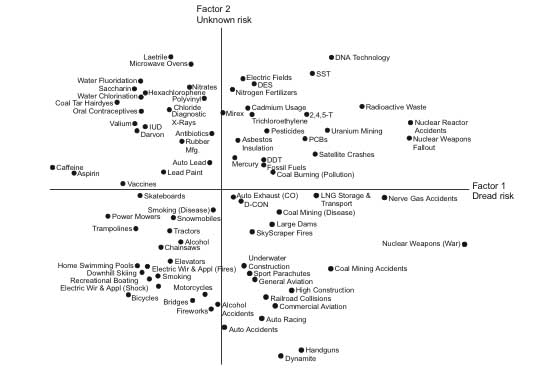
| Geology 140 - Environmental Geology | |||||
| Course Syllabus | Course Schedule | Assignments | Department Home Page | ||
Experts and the public tend to evaluate risk differently. These are the results of a 1987 study by Paul Slovic that laid the groundwork for the modern study of risk perception.
When asked to evaluate the risk of 30 common activities, people cited these factors in explaining why they believed activities to be more risky than the statistical risk of death would indicate:
Dread
Factor |
“Knowability”
factor |
||
Controllable |
Uncontrollable
|
Not
Observable |
Observable |
Not Dread
|
Dread |
Unknown
to Those Exposed |
Known to
those Exposed |
Consequences
Not Fatal |
Consequences
Fatal |
Effect Delayed |
Effect Immediate |
Equitable
|
Not Equitable
|
New Risk |
Old Risk
|
Individual
|
Catastrophic
|
Risk Unknown
to Science |
Risks Known
to Science |
Low Risk
to Future Generations |
High Risk
to Future Generations |
Example:
Genetically engineered food |
Example:
Bees |
Easily Reduced
|
Not Easily
Reduced |
||
Risk Decreasing |
Risk Increasing |
||
Voluntary |
Involuntary |
||
Example:
X-rays |
Example:
Nuclear power |
||

Source: Slovic, P., 1987, Perception of risk. Science, 236:280-285.
Vulnerability is a function of
Examples
Example of technological fixes:
Examples of social planning
If you have limited money to spend, where would you invest it?